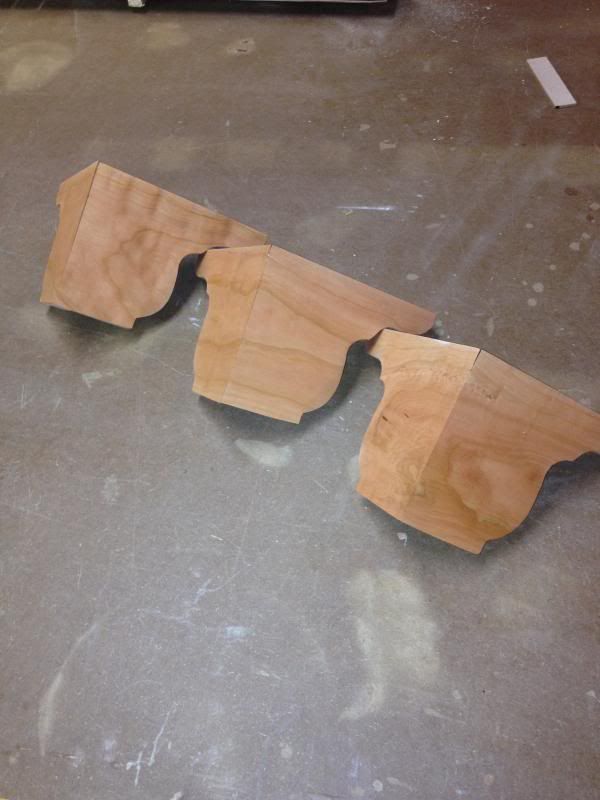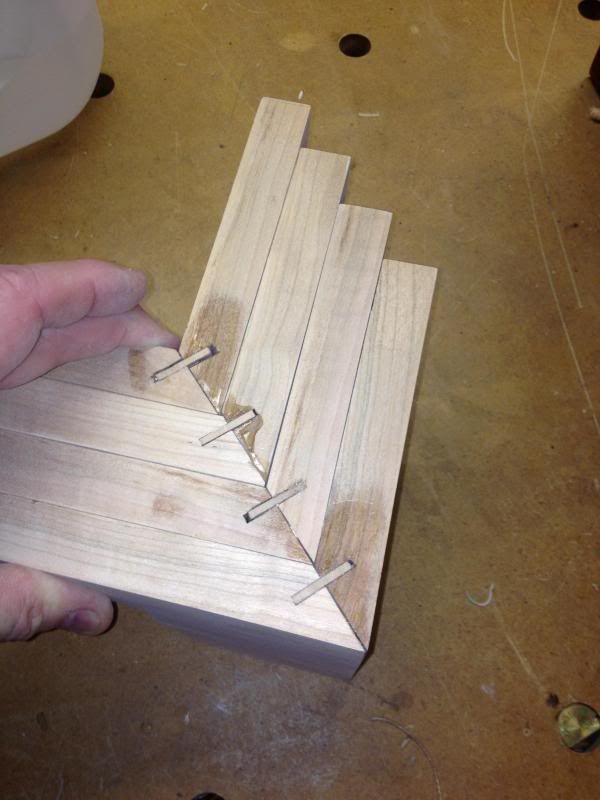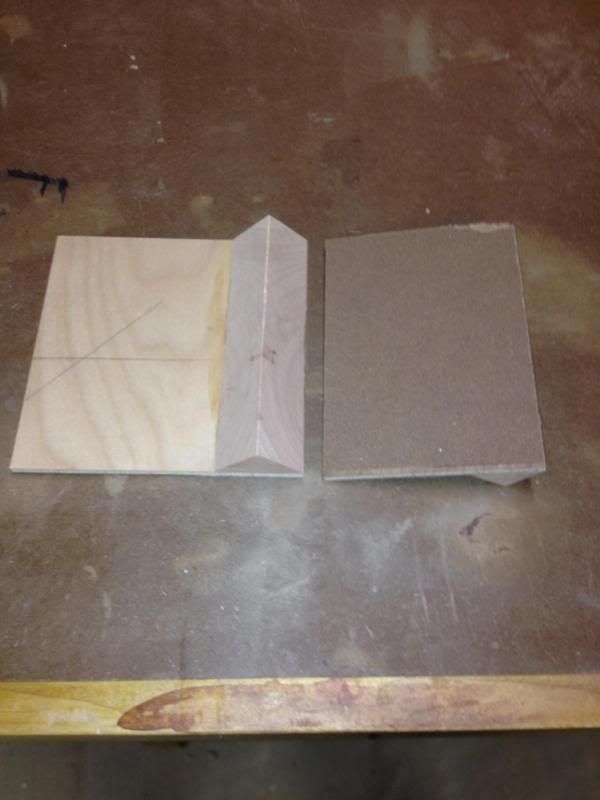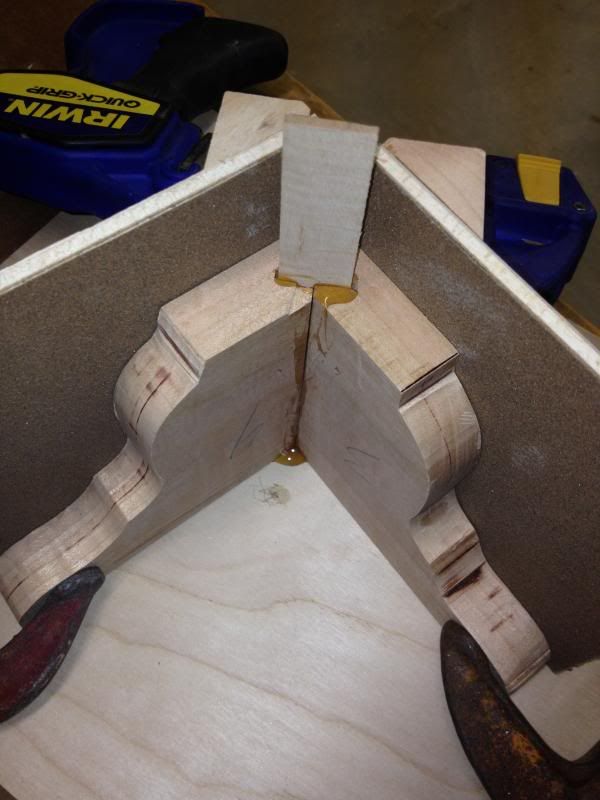http://i32.photobucket.com/albums/d9/Stonecove/Picture004.jpg







This is my first project blog. I learned a lot while making these splined miter joint feet, so I thought I would share with you.
I am in the process of building a Colonial style cherry side table with bracket feet of my own design. My last project was a similar designed TV cabinet, but with that project I purchased the mitered bracket feet. This time I thought I would try to make my own feet and thought I would post the method I used.
These feet are mitered and splined
The feet are made from 1 board of 1” cherry. I cut the feet from consecutive cuts along the board so the grain is as “book-matched” as possible. Number each piece on the inside so you can keep them matched. I cut the miters first using my table saw with the aid of an electronic angle finder (Wikey Digital angle gauge) I kept the set up the same for all cuts and flipped the board back and forth to get matching 45 degree angles.
I then laid our the profile for the feet and traced the pattern using a hardboard pattern I made up cutting the rough shape on the band saw. I tried to get the profile within 1/32” to 1/16 ” to the lay out line.
I then taped the hardboard pattern on the leg and used a flush trim router bit to get as close to the final dimension as possible. It is critical to make sure the bit is not taking too big a bite or to try to use it on the end grain to finish the rounded end. Don’t ask how I know this!!!!! I then use a hand rasp to clean up the radii and the end grain end. A sharp chisel and some sandpaper helped finish off the profile. Make certain when you rasp or sand that you pay attention to the show side so you don’t get blowout or round off what is supposed to be a sharp edge.
I then set up the table saw to make the spline grooves in the miters. (If I do this again I would do the slots before the band saw.) I set the blade to 45 degrees and using my Incra Miter gauge with a sacrificial fence clamped to the miter gauge. I then set a stop block on the in-feed side of my table saw blade. The stop block was clamped to the table saw fence. This is done so as to position the miter exactly the same for each leg. I used trial and error to adjust the blade height until I got a slot that was large enough to accept a 1” spline (1/2” on each side).
With the spline grooves cut I needed to be able to make 4 splines that would fit the slots tightly but with enough room to install them. Using the advice I got from posting my question in a thread in LJ, I chose to use cross grain cuts from the ends of a quarter-sawn board of cherry. I was told to use cross-grain splines as the strength of the spline needs to be parallel with the grain of the foot itself. Makes sense! So I set up a stop block on the table saw sled and began to run samples, changing the stop-block to get the exact tight slip fit. I had to cut 8 pieces of splines to get enough end grain splines to fill all the spline grooves.
Next was how to glue up the legs? I found an article in Fine Woodworking magazine where they used 45 degree triangles glued to small pieces of 1/4” ply as a way to apply clamping pressure across the miter. I glued the triangles to the ply then used spray adhesive on pieces of 150 grit sandpaper to attach the sandpaper to the inside surface of the clamping jig. After letting the glue dry, I then clamped the clamping jig to the leg so the edge of the jig showed the corner of the leg when glued together. See pictures I test fit the splined so I knew I had a slip fit that would slide in the slot. I applied hide glue on the mitered surfaces and in the slot, then stood the legs up on the top surface and lightly clamped the clamping jig across the miter. With the slots somewhat lined up I drove the splines carefully into the slots. It’s critical you have a sliding fit to start with as the glue fills the slot and you don’t want to use much hammer persuasion to get the splines installed. They are easily broken because they are end grain. Once the spline is installed from top to bottom, adjust the clamp to make sure the miter is tight all along the joint. Wipe of excess glue on the face of the legs. Let the glue set 24 hours before taking the clamps off.
Clean up the excess glue and you have finished mitered splined table legs!
One thing I found to be critical is to match up your splines with the grooves. You will notice one of the legs the joint is not perfectly aligned. That is due to using a spline that fit too loosely in the slot. Test the fit and lay out the pairs of legs and splines to avoid confusion and panic when the glue is applied.
So this is my long winded first blog that uses a bunch of newly acquired skills. I thought you might appreciate learning how a relative newby in woodworking made what I feel is a highly complex component of a piece of furniture. Hopefully the pictures will help with explanation. Now that I’ve done it, I would not hesitate to do even larger splined miter joints on future projects!
Thanks for reading this entry.
Michigander
Source: LumberJocks.com
Colonial Cherry side table #1: How I made mitered splined bracket feet

No comments:
Post a Comment